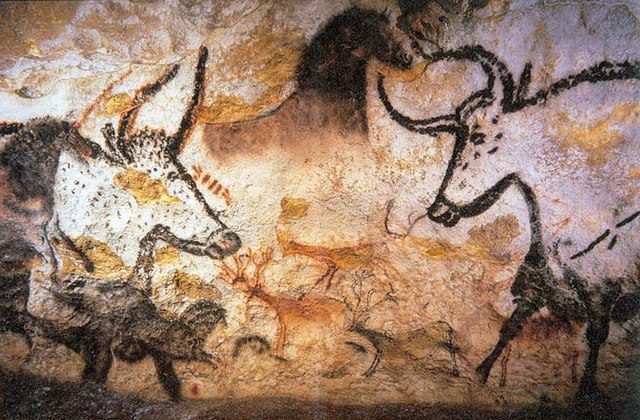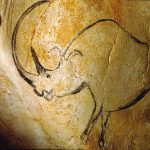
In the southwest of France, deep in the Dordogne region, lies a site that has captivated scientists, historians, and art lovers for decades—the Lascaux Caves. These caves hold one of the most important and mysterious collections of prehistoric art in the world. Created over 17,000 years ago, the Lascaux Cave Paintings are a true marvel of early human creativity, yet they also present puzzles that remain unsolved to this day. From their accidental discovery to their incredible preservation, the story of the Lascaux Cave Paintings is one that continues to intrigue and inspire.
The Unexpected Discovery: A Chance Encounter
The Lascaux Caves were discovered on September 12, 1940, by four teenage boys from the nearby village of Montignac—Marcel Ravidat, Jacques Marsal, Georges Agnel, and Simon Coencas. Accompanied by Ravidat’s dog, Robot, the boys were exploring the woods when they stumbled upon a hole that led into the caves. Excited by their find, they returned the next day with lanterns, only to be astonished by what they saw.
Inside, the walls were covered with intricate paintings of animals—bulls, horses, and stags—all rendered in vivid, natural colors. The boys immediately realized that this was no ordinary cave. They showed the site to their schoolteacher, who in turn contacted local experts. Word spread quickly, and soon, archaeologists and historians were flocking to the site to investigate.
While it was clear from the beginning that these paintings were prehistoric, no one could have anticipated the significance they would hold. The discovery of the Lascaux Cave Paintings would soon become one of the most important finds in the study of early human history and art.
The Paintings: A Detailed Look
The paintings found within the Lascaux Caves are nothing short of extraordinary. There are nearly 600 paintings spread across the cave walls, along with over 1,500 engravings. These artworks primarily depict animals, such as horses, aurochs (an extinct type of wild cattle), deer, and bison. The largest chamber, known as the Great Hall of the Bulls, is home to some of the most iconic images, including four massive bulls that seem to charge across the wall.
What’s particularly fascinating is the level of skill displayed in these paintings. The prehistoric artists used a variety of techniques, including outlines, shading, and even perspective, to bring their subjects to life. They also made use of the cave’s natural contours to enhance the three-dimensional effect of the animals. Despite their limited resources, they managed to create works of art that rival some modern-day masterpieces.
The pigments used to create these works were made from natural materials such as iron oxide, charcoal, and manganese. The colors—red, black, yellow, and brown—were applied using brushes made of animal hair or sticks, and in some cases, the artists even used their hands. Some figures appear to have been created with a form of primitive stenciling, with the artist blowing pigment over a hand or other object to leave an impression on the wall.
The question that remains is why these paintings were created. Were they purely decorative, or did they serve a deeper purpose? This is one of the many mysteries surrounding Lascaux.
The Mysteries: Unanswered Questions
One of the greatest questions surrounding the Lascaux Cave Paintings is, of course, why they were made. Some experts believe they served a ritualistic or religious purpose. The animals depicted could have been seen as symbols of strength or fertility, and the paintings may have been part of a hunting ritual. Others argue that the paintings were a form of early storytelling, documenting the lives of the people who created them.
There’s also the mystery of who the artists were. It’s likely that they belonged to the Upper Paleolithic people, also known as the Cro-Magnons, who lived in Europe around 20,000 years ago. However, there’s no way to know for certain who painted these scenes, or why they chose to do so in this particular cave.
Another intriguing question is why certain animals were depicted repeatedly, while others, such as reindeer—an important food source for Paleolithic people—were almost entirely absent from the paintings. Was this a deliberate omission, or was it simply a coincidence? These unanswered questions continue to fuel speculation and debate among researchers.
The Scientific Puzzle: Preservation and Decay
The Lascaux Cave Paintings may have been preserved for thousands of years, but their survival has become a race against time. When the caves were first opened to the public in 1948, the influx of visitors brought about unintended consequences. The body heat, breath, and artificial lighting introduced by humans began to alter the cave’s environment. Mold and lichen started to grow on the walls, threatening the integrity of the paintings.
In 1963, the French Ministry of Culture made the difficult decision to close the caves to the public in order to preserve the artwork. However, even with the caves sealed, the paintings have continued to suffer from environmental changes. Fungal outbreaks, likely caused by the new climate control systems, have posed a serious threat to the paintings, leading to the formation of black mold on some of the walls.
Today, efforts are being made to combat these issues. Conservationists work tirelessly to preserve the paintings, using the latest technology to monitor the cave’s conditions and prevent further damage. However, the threat of deterioration remains, and the future of these ancient masterpieces is uncertain.
Modern Fascination: Virtual Reality and Digital Replicas
Although the original Lascaux Caves are closed to the public, that doesn’t mean the magic of the paintings is inaccessible. In 1983, a replica of the cave, known as Lascaux II, was opened just a few hundred meters from the original site. This carefully constructed replica allows visitors to experience the beauty of the paintings without causing any further harm to the originals.
More recently, technology has allowed for even more innovative ways to explore Lascaux. Virtual reality (VR) tours have been created, allowing people from all over the world to walk through a digital version of the caves. These VR experiences are highly detailed and provide an immersive way to view the paintings in their original context. There are also online platforms where you can take a virtual tour of Lascaux from the comfort of your own home.
These digital replicas have become essential tools for teaching and preserving the legacy of Lascaux. They allow people to explore the paintings in incredible detail, while also ensuring that the originals remain protected. In this way, Lascaux continues to inspire new generations, even in the digital age.
The Role of Art in Prehistoric Society
Art has always been a form of communication, and the Lascaux Cave Paintings are no exception. While we may not know exactly what the creators were trying to convey, it’s clear that art held great significance for prehistoric people. These paintings offer a glimpse into their world—what they valued, what they feared, and how they related to the natural world around them.
Some experts suggest that the paintings could have been a way to convey information about hunting techniques or the migration patterns of animals. Others believe they may have had a spiritual significance, perhaps serving as a way to connect with the forces of nature or to ensure a successful hunt. Whatever the case, the Lascaux Cave Paintings demonstrate that art was an important part of life for these early humans.
Interestingly, some modern artists have drawn inspiration from prehistoric art, seeing it as a form of abstraction or minimalism. The simple yet powerful imagery of Lascaux continues to influence contemporary art, reminding us that the desire to create and express is a universal human trait.
Controversies and Debates
Like any major archaeological find, the Lascaux Cave Paintings have not been without controversy. One of the more fringe theories surrounding the paintings is the idea that they were created with the help of extraterrestrial beings. This theory, popularized by some proponents of ancient astronaut hypotheses, suggests that the advanced artistic techniques used in Lascaux are evidence of alien intervention. While this theory lacks scientific credibility, it highlights the sense of wonder and intrigue that surrounds the paintings.
More serious debates have emerged over the interpretation of the images. Some scholars argue that the paintings are purely decorative, while others see them as deeply symbolic. The lack of written records from the time means that we may never fully understand the purpose of these paintings, and this ambiguity has led to a wide range of interpretations.
There has also been debate over how best to preserve the paintings for future generations. Some argue that the caves should remain completely closed, while others believe that modern technology could allow for limited, controlled access. Balancing the need for preservation with the public’s desire to experience these ancient works of art firsthand remains a challenge for conservationists.
The Global Impact of Lascaux
The discovery of the Lascaux Cave Paintings had a profound impact on both the academic world and popular culture. For historians and archaeologists, the paintings provided new insights into the lives of prehistoric humans. For artists, they offered a direct link to the earliest forms of human creativity. And for the general public, they became a symbol of the mystery and wonder of the ancient world.
The influence of Lascaux can be seen in various aspects of modern culture. The paintings have been referenced in films, books, and video games, and their aesthetic has been incorporated into various forms of contemporary art. Lascaux has also become a major tourist attraction, with thousands of visitors flocking to see the replica caves and explore the region’s prehistoric past.
The importance of Lascaux goes beyond its artistic value. It serves as a reminder of the shared history of humanity and the enduring power of creativity. These paintings, created thousands of years ago, continue to captivate and inspire people around the world.
The Eternal Mystery
The Lascaux Cave Paintings remain one of the greatest mysteries of human history. Despite decades of study, there is still much we don’t know about who created them, why they were made, or what they mean. Yet it is this mystery that makes them so fascinating. The paintings offer a window into a world that is both distant and familiar, reminding us of the creativity and ingenuity that have defined humanity from the very beginning.
As the French archaeologist and prehistorian Jean Clottes once said, “The caves have a voice, if only we listen.” The Lascaux Cave Paintings may never reveal all their secrets, but they continue to speak to us across the millennia, inviting us to explore the mysteries of our ancient past.




